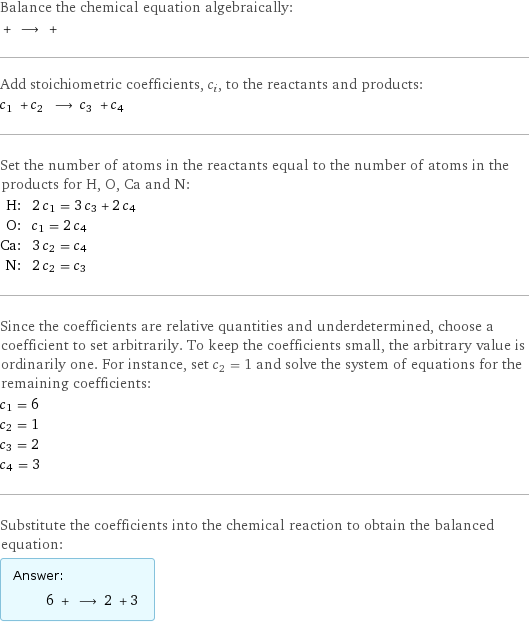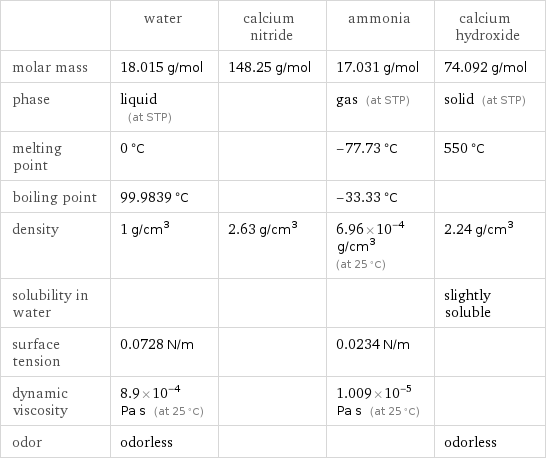Input interpretation

water + calcium nitride ⟶ ammonia + calcium hydroxide
Balanced equation

Balance the chemical equation algebraically: + ⟶ + Add stoichiometric coefficients, c_i, to the reactants and products: c_1 + c_2 ⟶ c_3 + c_4 Set the number of atoms in the reactants equal to the number of atoms in the products for H, O, Ca and N: H: | 2 c_1 = 3 c_3 + 2 c_4 O: | c_1 = 2 c_4 Ca: | 3 c_2 = c_4 N: | 2 c_2 = c_3 Since the coefficients are relative quantities and underdetermined, choose a coefficient to set arbitrarily. To keep the coefficients small, the arbitrary value is ordinarily one. For instance, set c_2 = 1 and solve the system of equations for the remaining coefficients: c_1 = 6 c_2 = 1 c_3 = 2 c_4 = 3 Substitute the coefficients into the chemical reaction to obtain the balanced equation: Answer: | | 6 + ⟶ 2 + 3
Structures

+ ⟶ +
Names

water + calcium nitride ⟶ ammonia + calcium hydroxide
Equilibrium constant
![K_c = ([NH3]^2 [Ca(OH)2]^3)/([H2O]^6 [Ca3N2])](../image_source/ac77ba74bce393a574f618b5a9ba6b7b.png)
K_c = ([NH3]^2 [Ca(OH)2]^3)/([H2O]^6 [Ca3N2])
Rate of reaction
![rate = -1/6 (Δ[H2O])/(Δt) = -(Δ[Ca3N2])/(Δt) = 1/2 (Δ[NH3])/(Δt) = 1/3 (Δ[Ca(OH)2])/(Δt) (assuming constant volume and no accumulation of intermediates or side products)](../image_source/8c74ea364bcac0f9d42d82b419f6ee03.png)
rate = -1/6 (Δ[H2O])/(Δt) = -(Δ[Ca3N2])/(Δt) = 1/2 (Δ[NH3])/(Δt) = 1/3 (Δ[Ca(OH)2])/(Δt) (assuming constant volume and no accumulation of intermediates or side products)
Chemical names and formulas

| water | calcium nitride | ammonia | calcium hydroxide Hill formula | H_2O | Ca_3N_2 | H_3N | CaH_2O_2 name | water | calcium nitride | ammonia | calcium hydroxide IUPAC name | water | calcium azanidylidenecalcium | ammonia | calcium dihydroxide
Substance properties

| water | calcium nitride | ammonia | calcium hydroxide molar mass | 18.015 g/mol | 148.25 g/mol | 17.031 g/mol | 74.092 g/mol phase | liquid (at STP) | | gas (at STP) | solid (at STP) melting point | 0 °C | | -77.73 °C | 550 °C boiling point | 99.9839 °C | | -33.33 °C | density | 1 g/cm^3 | 2.63 g/cm^3 | 6.96×10^-4 g/cm^3 (at 25 °C) | 2.24 g/cm^3 solubility in water | | | | slightly soluble surface tension | 0.0728 N/m | | 0.0234 N/m | dynamic viscosity | 8.9×10^-4 Pa s (at 25 °C) | | 1.009×10^-5 Pa s (at 25 °C) | odor | odorless | | | odorless
Units
